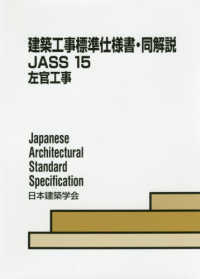- ホーム
- > 洋書
- > 英文書
- > Computer / General
基本説明
Introduces the basic array structure and explores the fundamentals of implementing and using multi-dimensional arrays.
Full Description
More and more programmers are turning to Python and this book will give them the understanding they need. Necaise introduces the basic array structure and explores the fundamentals of implementing and using multi-dimensional arrays. The underlying mechanisms of many of Python's built-in data structures and constructs are covered. A number of ADTs and applications are discussed as threads throughout the book to allow for multiple implementations as new data structures are introduced. Real-world applications of the various chapter topics are also presented. This gives programmers complete coverage of abstraction and the basic data structures and algorithms in the Python language.
Contents
Preface. Chapter 11.2 The Date Abstract Data Type. 1.3 Bags. 1.4 Iterators. 1.5 Application: Student Records. Exercises. Programming Projects. Chapter 2: Arrays. 2.1 The Array Structure. 2.2 The Python List. 2.3 Two-Dimensional Arrays. 2.4 The Matrix Abstract Data Type. 2.5 Application: The Game of Life. Exercises. Programming Projects. Chapter 3: Sets and Maps. 3.1 Sets. 3.2 Maps. 3.3 Multi-Dimensional Arrays. 3.4 Application: Sales Reports. Exercises. Programming Projects. Chapter 4: Algorithm Analysis. 4.1 Complexity Analysis. 4.2 Evaluating the Python List. 4.3 Amortized Cost. 4.4 Evaluating the Set ADT. 4.5 Application: The Sparse Matrix. Exercises. Programming Projects. Chapter 5: Searching and Sorting. 5.1 Searching. 5.2 Sorting. 5.3 Working with Sorted Lists. 5.4 The Set ADT Revisited. Exercises. Programming Projects. Chapter 6: Linked Structures. 6.1 Introduction. 6.2 The Singly Linked List. 6.3 The Bag ADT Revisited. 6.4 More Ways to Build a Linked List. 6.5 The Sparse Matrix Revisited. 6.6 Application: Polynomials. Exercises. Programming Projects. Chapter 7: Stacks. 7.1 The Stack ADT. 7.2 Implementing the Stack. 7.3 Stack Applications. 7.4 Application: Solving a Maze. Exercises. Programming Projects. Chapter 8: Queues. 8.1 The Queue ADT. 8.2 Implementing the Queue. 8.3 Priority Queues. 8.4 Application: Computer Simulations. Exercises. Programming Projects. Chapter 9: Advanced Linked Lists. 9.1 The Doubly Linked List. 9.2 The Circular Linked List. 9.3 Multi-Linked Lists. 9.4 Complex Iterators. 9.5 Application: Text Editor. Exercises. Programming Projects. Chapter 10: Recursion. 10.1 Recursive Functions. 10.2 Properties of Recursion. 10.3 How Recursion Works. 10.4 Recursive Applications. 10.5 Application: The Eight-Queens Problem. Exercises. Programming Projects. Chapter 11: Hash Tables. 11.1 Introduction. 11.2 Hashing. 11.3 Separate Chaining. 11.4 Hash Functions. 11.5 The HashMap Abstract Data Type. 11.6 Application: Histograms. Exercises. Programming Projects. Chapter 12: Advanced Sorting. 12.1 Merge Sort. 12.2 Quick Sort. 12.3 How Fast Can We Sort? 12.4 Radix Sort. 12.5 Sorting Linked Lists. Exercises. Programming Projects. Chapter 13: Binary Trees. 13.1 The Tree Structure. 13.2 The Binary Tree. 13.3 Expression Trees. 13.4 Heaps. 13.5 Heapsort. 13.6 Application: Morse Code. Exercises. Programming Projects. Chapter 14: Search Trees. 14.1 The Binary Search Tree. 14.2 Search Tree Iterators. 14.3 AVL Trees. 14.4 The 2-3 Tree. Exercises. Programming Projects. Appendix A Python Review. A.1 The Python Interpreter. A.2 The Basics of Python. A.3 User Interaction. A.4 Control Structures. A.5 Collections. A.6 Text Files. A.7 User-Defined Functions. Appendix B User-Defined Modules. B.1 Structured Programs. B.2 Namespaces. Appendix C Exceptions. C.1 Catching Exceptions. C.2 Raising Exceptions. C.3 Standard Exceptions. C.4 Assertions. Appendix D Classes. D.1 The Class Definition. D.2 Overloading Operators. D.3 Inheritance. D.4 Polymorphism.








